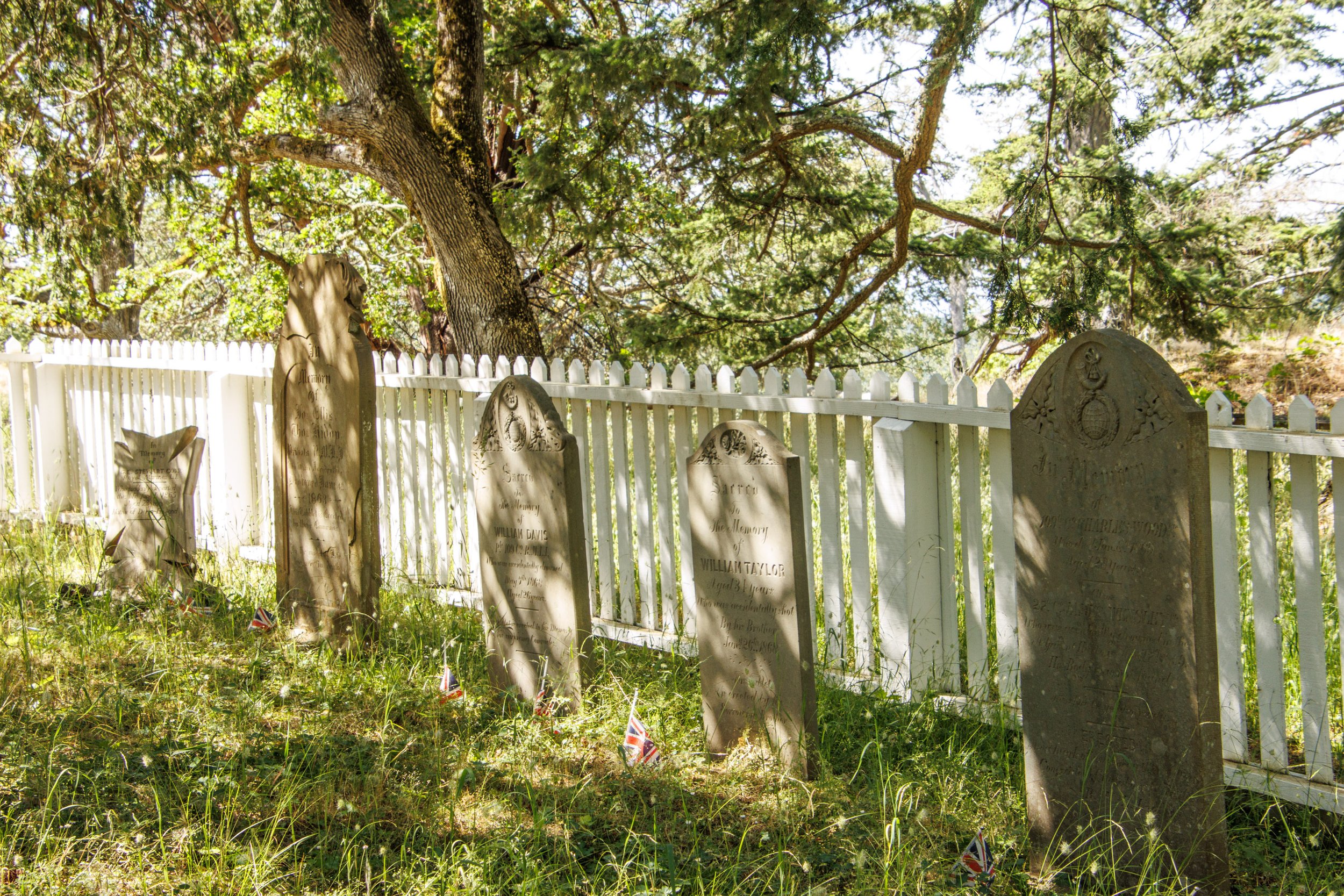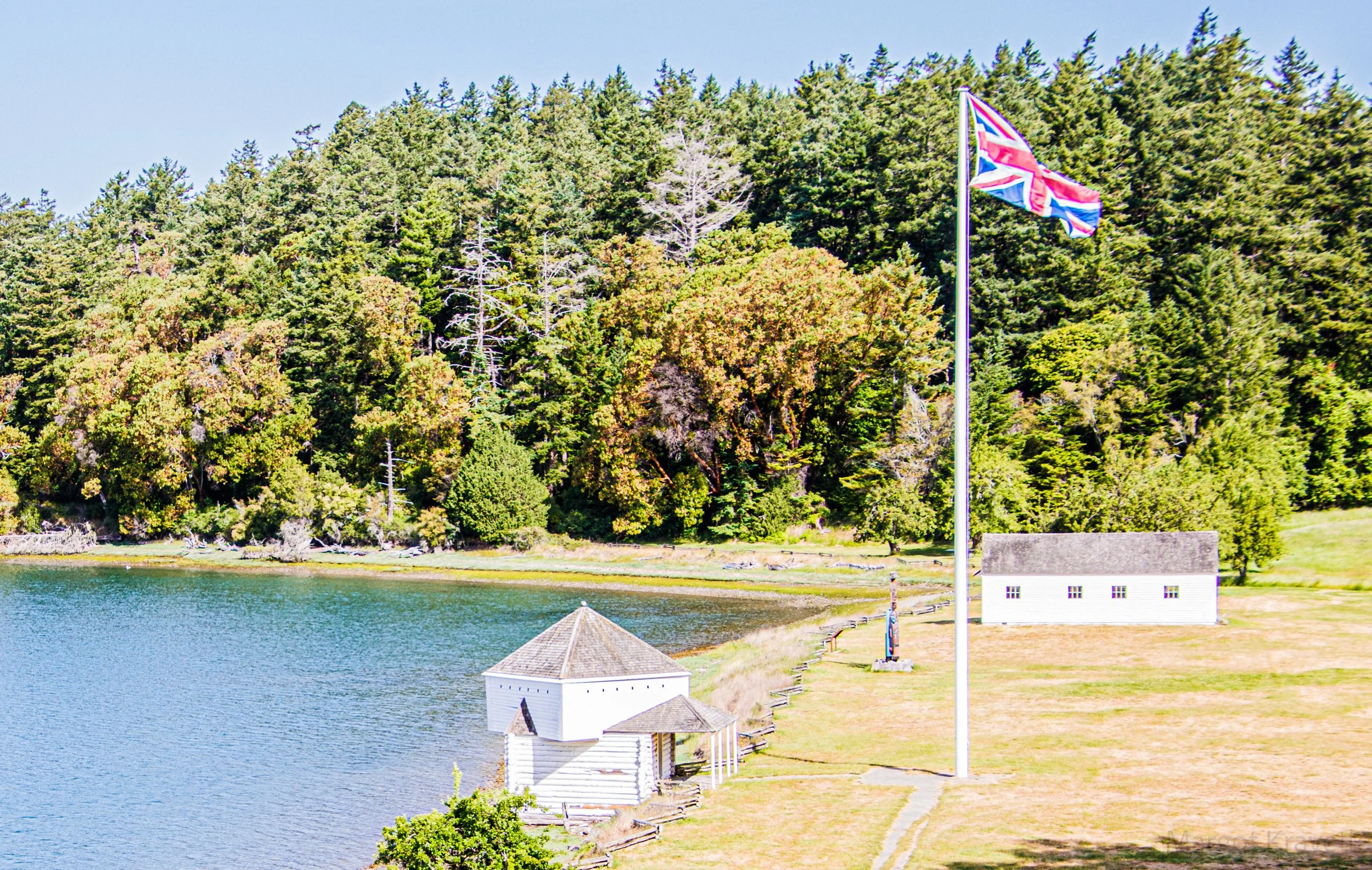The Pig War
A long, long time ago, long after the Native Americans occupied and prospered on what are now known as the San Juan Islands both the American and the British militaries occupied San Juan Island.
The two sides had signed a resolution in 1818 for joint occupation of the region, and in 1846 a treaty was signed that set the boundaries of the region. But the location of all of the San Juan islands was inadvertently left between the boundaries, and both sides claimed the entire island group. In 1859 a dispute between the two sides left the ownership of the San Juan Island without a recognized title. This dispute almost resulted in what has come to be known as the Pig War in that year.
With the fertile farmland, perfect for grazing, the Hudson Bay Company from Vancouver, had established a sheep farm in the southern end of the island. The area was also occupied by some Americans, some of whom had their own gardens. One day one of the pigs belonging to the Hudson Bay Company wandered over to those gardens and ate some potatoes belonging to one of the Americans, Lyman Cutlar, who shot and killed the pig. The British threatened to kill Cutlar and to evict all of the Americans from the island.
As you can imagine, with island occupancies by both sides, this incident turned into an international issue. Fortunately, negotiations successfully cooled the situation. However, with still no decision about ownership, both governments established their own camps where their militaries lived and worked. In 1860 the British Royal Marines landed on the island and set up camp, now known as the English Camp, on the northwest side of the island. The United States set up their camp, now known as the American Camp, on the southern tip, overlooking the Strait of Juan de Fuca and South Beach, and partially overlapping the Hudson Bay Company’s sheep farmland. For the next 12 years San Juan Island remained under a peaceful joint military occupation.
In 1871 the boundary question was raised again, and both sides agreed to arbitration. Since this was an international issue, both the English and the Americans agreed to send the question to the Emperor of Germany who delegated the decision making to Germany’s Kaiser Wilhelm I. After a recommendation from a three-person commission that reviewed the many details from the previous 50 years, Kaiser Wilhelm I ruled that the islands belonged to the United States. The Royal Navy left in 1872 and the American troops left two years later. San Juan Island would be long remembered for the “war” in which the only casualty was a pig.
National Park Service
Both the American and English camps are now part of the National Park Service and are together officially known as the San Juan Island National Historical Park, together encompassing 2,146 acres. The camps are well maintained and are each staffed by a single forest ranger and several volunteers. We ran into both forest rangers, Cyrus at American Camp and Alison at English Camp, who provided extremely helpful information and guidance about their respective parks.
American Camp
At the south end of the island lies the prairie and forest of American Camp. Over nine miles of trails take you through grassy prairies up to Mount Finlayson with distant views of the Cattle Point Lighthouse, and down to South Beach, the longest public beach in the San Juan islands where you have gorgeous views of the Olympic Mountains and the Strait of Juan de Fuca.
Most of the original buildings at American Camp had been transferred from Fort Bellingham when they were no longer needed to protect settlers from Indians in British Columbia and Alaska. Later, following the withdrawal of the military units, the U.S. Army Quartermaster Corps auctioned off the American Camp buildings. The original officers’ quarters was sold and renamed the Adam C. Brown House, and it sat on the corner of First and West Streets in Friday Harbor for 130 years. Ownership of the house was transferred to the National Park Service by owners of the Friday Harbor House Hotel in 2010 and it once again sits at American Camp.
The remaining buildings at American Camp are the Officers Quarters and the Laundress Quarters. The Redoubt also remains, and there is a newly refinished Visitors Center. Far from our current laundry practices, the laundress process at American Camp was quite different, and required several days to complete multiple steps. Clothes were soaked overnight, soaped up and heated in boiling water, rinsed, wrung, dried, starched and ironed – all by hand. There were usually four laundresses, each of whom did laundry for 20 soldiers. They were paid $1 per soldier per month, making their salaries higher than most soldiers. There is currently one of the original two laundress building remaining.
I was unfamiliar with the term “redoubt” and learned from Merriam-Webster that it is “1. A small, usually temporary, enclosed defensive work, and 2. a defended position or protective barrier”. Roberts Redoubt is a man-made fortification that was used as a commanding post during the years of the Pig War. At least 100 men used picks and shovels to alter the landscape, which included massive boulders in order to reach the right height. Prior to the occupation the area was densely forested with Douglas Firs. Its name honors the military career of Henry Roberts, who later wrote the Roberts Rules of Order.
A seasonal residence of more than 200 species of migratory birds, American Camp is home to a nesting pair of bald eagles, an abundance of red foxes, orcas and other marine mammals that are frequent visitors to the waters off South Beach. Foxes are frequently spotted where they prey on rabbits, although we saw two of them walking on the side of the street where we drove. Orcas, humpback and gray whales can be spotted from both camps.
American Camp is also the home of the world’s only viable population of the “island marble butterfly” which was thought to have been extinct for 90 years before being rediscovered in 1998. The Park Service and regional and local conservation groups do a tremendous amount to assure the continuation of this species of butterfly.
English Camp
Located 9 miles from Friday Harbor, the English Camp is located on the shores of Garrison Bay where you can enjoy views of Haro Strait and see Bell Point and the small Guss Island. The In addition to the visitors center which occupies the original barracks, are the Blockhouse that protects the soldiers from all directions, the Commissary (now the Visitors Center) and the formal gardens. When we were there, an osprey had built a nest on top of a tall tree, and the National Park Service had set up a video camera of the nest and of the birds coming and going, which could be viewed real time in the visitors center.
If you take a very short hike up the trail, you will reach a hilltop, which provides an aerial view of the formal gardens. It is also where the senior officer housing was located. One of the commanders, having arrived late in the game, decided to build housing on that level for his family and for the family of the second in command. There is nothing remaining there but the view which provides an overview of the camp.
There are several vigorous hikes at English Camp. We took the winding trail to the cemetery. Not too far beyond is the top of Young Hill, with views of Vancouver Island, Haro Strait and the Olympic Mountains. A longer loop on the Bell Point Trail takes you through woodland and along the bay providing a very different, and also beautiful scenery and views. The Lummi Indians believe that Guss Island is the location of their origin. The island is used for the some of the tribe’s ceremonial activities and is also the site of several very old Indian burial sites that have been relocated to the island where they were first located.
Just north of the camp are 2,920 feet of shoreline, accessible by boat or park trail, that are open to digging for native littleneck clams, butter clams, cockles, horse clams, and eastern softshell clams. Most of the tidelands directly adjacent to the camp are not available for harvesting because they are part of an archeological site. Guss Island is also off limits for digging.
In 2016, in honor of the 100th anniversary of the founding of the National Park Service, a set of totem poles were dedicated at English Camp near the site of a Coast Salish village. The poles, representing traditional reef net fishing, were dedicated by members of the Lummi and Spanish Nations.
On Saturdays from June through August, park rangers and volunteers recreate some of the skills of military and civilian life during the island’s early pioneer period. For an entire weekend in July, the park hosts a reenactment of life in the mid-19th-century camp.
Union Jack still flies over English Camp. It is one of the only flags in the world that is raised and lowered by U.S. government employees at a place without diplomatic status. The U.S. Park Service provides that service every day.
There is a tremendous amount of information about the Pig War that can be found on every website about the American and English Camps and the San Juan Island National Historical Park, including the military leaders of each of the camps, significant dates, and all of the associated activities that took place during the years from 1818 to 1873. There are also several books about the Pig War. If I had included all of those details in this post you would still be reading. It’s a fascinating story.
















